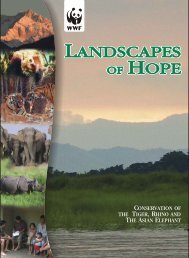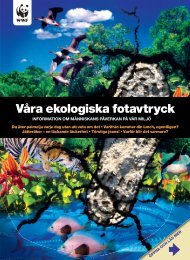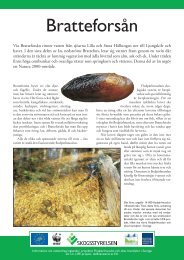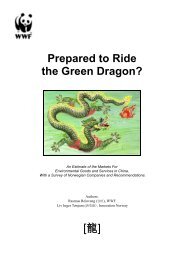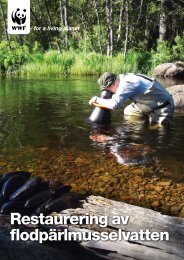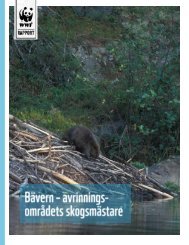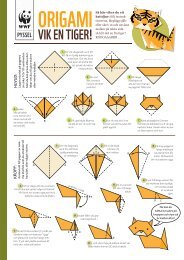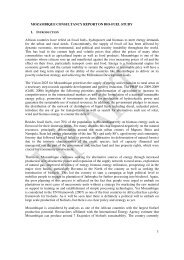FPM projects in Europe - Världsnaturfonden WWF
FPM projects in Europe - Världsnaturfonden WWF
FPM projects in Europe - Världsnaturfonden WWF
- No tags were found...
Create successful ePaper yourself
Turn your PDF publications into a flip-book with our unique Google optimized e-Paper software.
Cover:Author:Photos:Dr Robert Vandré tells about the Freshwater Pearl Mussel <strong>in</strong> streamSüdliche Regnitz, Germany.Lennart Henrikson, <strong>WWF</strong> Sweden, Ulriksdals Slott, S-170 81 Solna,Sweden, lennart.henrikson@wwf.seLennart Henrikson and Sofi Alexanderson/<strong>WWF</strong> SwedenJuly, 2009 © <strong>WWF</strong> Sweden
• Common river mussel project <strong>in</strong> Bavaria,Germany• Restoration of Pearl mussel population <strong>in</strong>the Ardennes, Luxembourg(LIFE05NAT/L/000116)• Conservation of habitats of pearl mussels<strong>in</strong> Belgium Life Moules Perlières(LIFE02NAT/B/008590)• Headwater streams and faunistic heritageassociated (LIFE04NAT/FR/000082).We also visited professor Klaus Wächtler.The participants wereMs Askia Wittern, Oueens College, Belfast,Northern Ireland (present e-mail addressaskia.wittern@skogsstyrelsen.se)Mr Håkan Söderberg, County Adm<strong>in</strong>istrationBoard of Västernorrland, Sweden(hakan.soderberg@y.lst.se)Dr Mart<strong>in</strong> Österl<strong>in</strong>g, Karlstad University,Sweden (mart<strong>in</strong>.osterl<strong>in</strong>g@kau.se)Dr Lennart Henrikson, <strong>WWF</strong> Sweden(lennart.henrikson@wwf.se).Latvia 2007Dur<strong>in</strong>g July 29 and August 3 2007 we visiteda number <strong>FPM</strong> streams <strong>in</strong> Latvia. The hostwas the Malacological Society of Latvia, Dr.Mudite Ruditze. We studied <strong>FPM</strong> streams <strong>in</strong>the Gauja national park:• River Gauja• Stream Amata• Stream Perlupe• Stream Strikjupe• Stream Rauza.The participants wereMs Sofi Alexanderson, <strong>WWF</strong> SwedenMr Jakob Bergengren, County Adm<strong>in</strong>istrationBoard of Jönköp<strong>in</strong>g, Sweden(jakob.bergengren@f.lst.se)Dr Lennart Henrikson, <strong>WWF</strong> SwedenMr Håkan Söderberg, County Adm<strong>in</strong>istrationBoard of Västernorrland, SwedenScotland 2008Dur<strong>in</strong>g June 23 and July 26 2008 we visited<strong>projects</strong> <strong>in</strong> Scotland. We visited:• River Kerry• River Moriston• Scottish Natural Heritage• Fish lab• River SpeyThe participants wereMs Sofi Alexanderson, <strong>WWF</strong> Sweden DrBjörn Arvidsson, Karlstad University(bjorn.arvidsson@kau.se)Mr Erik Degerman, Fishery Board ofSweden, (erik.degerman@fiskeriverket.se)Dr Lennart Henrikson, <strong>WWF</strong> SwedenMr Oskar Norrgrann, County Adm<strong>in</strong>istrationBoard of Västernorrland, Sweden(oscar.norrgrann@y.lst.se)Mr Håkan Söderberg, County Adm<strong>in</strong>istrationBoard of Västernorrland, Sweden Dr JohanTörnblom, Swedish University ofAgricultural Sciences(johan.tornblom@smsk.slu.se)Ms Askia Wittern, Swedish Forest Agency(askia.wittern@skogsstyrelsen.se)The objective of the reportThe objective of this report is to make a shortpresentation of some mussel <strong>projects</strong> whichhopefully will <strong>in</strong>crease the awareness andfacilitate network<strong>in</strong>g activities among aquaticconservationists.We present the objectives, actions and results.In most of the <strong>projects</strong> it is impossible toshow if the actions have been successful, i.e.recruitment of mussels, as it takes 5-10 yearsuntil the small mussels can easily be observedwithout disturb<strong>in</strong>g the habitat. This meansthat the results mostly are related to theperformance of the actions.Other <strong>FPM</strong> <strong>projects</strong>We did not have the opportunity to visit all<strong>FPM</strong> <strong>projects</strong> <strong>in</strong> <strong>Europe</strong>. There are ongo<strong>in</strong>g<strong>projects</strong> as well as f<strong>in</strong>ished ones <strong>in</strong> e.g.Norway, F<strong>in</strong>land, Russia, Ireland, NorthernIreland, England, Austria, and Spa<strong>in</strong>.7
The Freshwater Pearl Mussel and its habitat <strong>in</strong> SwedenFish passage made like a small stream around a dam <strong>in</strong> the freshwater pearl mussel stream Nötån.ObjectiveThe objective is to develop and test methodsto achieve favourable conservation status forthe <strong>FPM</strong> <strong>in</strong> 21 Natura 2000 streams <strong>in</strong>Sweden.Actions• Develop<strong>in</strong>g of plann<strong>in</strong>g methods• Measures to improve the conditions for<strong>FPM</strong> as well as the host fish species- clean<strong>in</strong>g of bottom substrate- new gravel bottoms- restoration of riparian areas- clos<strong>in</strong>g of ditches enter<strong>in</strong>g the <strong>FPM</strong>streams- construction of fishways.• Information to the landowners and otheractors with<strong>in</strong> the dra<strong>in</strong>age area• Re-<strong>in</strong>troduction of <strong>FPM</strong>• Summaris<strong>in</strong>g the experiences <strong>in</strong> a manualfor conservation of streams <strong>in</strong>habit<strong>in</strong>g<strong>FPM</strong>• International conference, August 2009Results/experiences• Most of the planned actions have beensuccessfully performedRestoration of riparian area. Planted trees ofNorwegian spruce have been cut and removed <strong>in</strong>order to establish a more natural riparian area <strong>in</strong>Stream Sollumsån.8
Publications“The Freshwater Pearl Mussel – a jewel ofthe forest landscape.” Brochure <strong>in</strong> Swedish.Clean<strong>in</strong>g of bottom substrate <strong>in</strong> StreamBratteforsån. Photo: Sofi AlexandersonHenrikson, L. The Freshwater Pearl MusselMargaritifera margaritifera and its habitatson Sweden – a LIFE project. In: Vandré,R. & Schmidt, C. (Eds.) 2006. Proceed<strong>in</strong>gsfrom the Workshop ”Pearl MusselConservation and River Restoration” 15-16.11.2005 <strong>in</strong> Bad Elster, Germany.Bezirk Oberfranken & AnglerverbandSüdsachsen Mulde/Elster e. V. PP 15-20.Degerman, E, Alexanderson, S. Bergengren,J., Henrikson, L., Johansson, B-E., Larsen,B.M. Söderberg, H. 2009. Restoration offreshwater pearl mussel streams. <strong>WWF</strong>Sweden, Solna.Contact detailsProject identification:LIFE04NAT/SE/000231Home page: www.wwf.se/fpm (<strong>in</strong> English),www.wwf.se/flodparlmussla (<strong>in</strong> Swedish)Personal contact: Sofi Alexanderson andLennart Henrikson, <strong>WWF</strong> Sweden,Ulriksdals Slott, S-170 81 Solna, Sweden.e-mail: sofi.alexanderson@wwf.selennart.henrikson@wwf.seSofi Alexanderson re-<strong>in</strong>troduces <strong>FPM</strong> <strong>in</strong>toStream Silverån.9
The Lutter project, Niedersachsen, GermanyStream LutterThe upper part of Stream Lutter was dra<strong>in</strong>ed and channelized but wetland has beenrecreated by the project.Stream Lutter is situated at the Lüneburger Heide<strong>in</strong> Lower Saxony (Niedersachsen) <strong>in</strong> the northernpart of Germany. <strong>FPM</strong> was formerly a commonspecies <strong>in</strong> the area but today it is only found <strong>in</strong>the Lutter.The Lutter project was <strong>in</strong>itiated and f<strong>in</strong>anced bycity councils Celle and Gifhorn <strong>in</strong> LowerSaxony, the county Lower Saxony and thegovernment (Bundesamt für Naturschutz).Our host was Dr Re<strong>in</strong>hard Altmüller and hiscolleagues Mr Ra<strong>in</strong>er Dettmer and professorKlaus Wächtler.ObjectiveThe ma<strong>in</strong> objectives are to protect Lutter andimprove the stream habitats for <strong>FPM</strong>.• Semi-artificial glochidia <strong>in</strong>fection of Browntrout.ActionsExamples:• Protection of buffer zones along the stream.• Restoration of stream channel.• Reduction of sand and f<strong>in</strong>e sediment load.A section of the restored Stream Lutter<strong>in</strong>habit<strong>in</strong>g young <strong>FPM</strong>.Results/experiencesThe Lutter project is the most expensive projecton <strong>FPM</strong> <strong>in</strong> <strong>Europe</strong> but also the only one which10
has shown results <strong>in</strong> terms of recruitment of<strong>FPM</strong>!• A buffer zone of land was purchased to get aprotection of the Lutter. Most of the moneywas spent on this action.• In the upper part of Lutter the stream wasdeepened and straightened <strong>in</strong> order to get landfor grass harvest and graz<strong>in</strong>g. Severeal km ofthe channel was restored.• Sediment traps were constructed and preventsand (and other material) enter<strong>in</strong>g the stream.One trap for coarser material and another onefor f<strong>in</strong>er material. The sediment traps have tobe place near the stream.• Infection of native 0+ Brown trout was made<strong>in</strong> the laboratory and the fishes were released<strong>in</strong>to the stream. Brown trout from fish farmswas no good host.• Today the percentage of young mussels is fargreater than before and the young musselshave been observed to reproduce.PublicationsAltmüller; R. & Dettmer, R. 2006. Successfulspecies protection measures for the FreshwaterPearl Mussel (Margaritifera margaritifera)through the reduction of unnaturally highload<strong>in</strong>g of silt and sand <strong>in</strong> runn<strong>in</strong>g waters –Experiences with<strong>in</strong> the scope of theLutterproject .(This pdf-file is the English version of anarticle which is published with three otherarticles deal<strong>in</strong>g with species and biotopeprotection for the freshwater pearl musselMargaritifera margaritifera <strong>in</strong> Lower Saxony,North Germany (see:http://www.nlwkn.niedersachsen.de/master/C35794242_N14750639_L20_D0_I5231158.html).)Contact detailsDr. Re<strong>in</strong>hard AltmüllerNiedersächsischer Landesbetrieb fürWasserwirtschaft, Küsten- undNaturschutz (NLWKN)Betriebsstelle Hannover-HildesheimAufgabenbereich 44 (Tier- undPflanzenartenschutz)Gött<strong>in</strong>ger Chaussee 76 A30453 Hannovere-mail: Re<strong>in</strong>hard.Altmueller@NLWKN-H.Niedersachsen.deSand filter approx. 300 m from Lutter.Filter for f<strong>in</strong>e material approx. 25 m from Lutter.Dr Re<strong>in</strong>hard Altmüller and Mr Ra<strong>in</strong>er Dettmer.11
Large freshwater mussels Unionoidea <strong>in</strong> the border area ofBavaria, Saxonia & Czech Republic, GermanyRobert Vandré shows ditches made to prevent iron (ochre) to enter the stream Südliche Regnitz.Südliche RegnitzThe stream Südliche Regnitz, where threecountries meet (Bavaria, Saxony and the Czechrepublic), <strong>in</strong>habits <strong>FPM</strong> as well as the CommonRiver Mussel Unio crassus.The stream faces the very common problems –eutrophication and siltation due to agriculture andsewage. This is supposed to be the reason for thelack of young mussels.Our hosts were Dr Robert Vandré and MsChrist<strong>in</strong>e Schmidt.ObjectiveThe ma<strong>in</strong> objective is to protect the twothreatened mussels species.ActionsExamples:• Construction of silt traps to decrease the loadof silt to the stream• Instream measures to restore the habitat.• Artificial <strong>in</strong>fection of brown trout <strong>in</strong> a fishfarm, collection of the post parasitic youngmussels and release <strong>in</strong>to the stream.• Artificial <strong>in</strong>fection of native m<strong>in</strong>nows withglochidia of Unio crassus and release <strong>in</strong>to thestream.Results/experiences• Eight silt traps (se picture, next page) werebuilt <strong>in</strong> tributaries and caught 20-30 tonnesper year.• Sediment taken from the stream, washed andreturned reta<strong>in</strong>ed low silt content for 3 yearsbut was not stable.• Newly constructed, paved passages for cattlecross<strong>in</strong>g the stream successfully m<strong>in</strong>imizedthe loss of silt. See picture, next page.• Dead wood and stones were added to thestream to <strong>in</strong>crease the biotope heterogeneity,caus<strong>in</strong>g a strong <strong>in</strong>crease of the m<strong>in</strong>nowpopulation, ma<strong>in</strong> host fish of Unio crassus.12
• Juveniles of Unio crassus were found at theend of the project, orig<strong>in</strong>at<strong>in</strong>g from theartificial <strong>in</strong>fection of m<strong>in</strong>now.recruitment of <strong>FPM</strong> was observed <strong>in</strong> oneriver section.• Released young mussels of the <strong>FPM</strong> couldnot been recaptured so far. Recent naturalPublicationsVandré, R. & Schmidt, C. (Eds.) 2006.Proceed<strong>in</strong>gs from the Workshop ”PearlMussel Conservation and River Restoration”15-16.11.2005 <strong>in</strong> Bad Elster, Germany. BezirkOberfranken & Anglerverband SüdsachsenMulde/Elster e. V.Contact detailsProject identification:LIFE2002NAT/D/8458Home page: http://www.life.bezirkoberfranken.de/Personal contact: Dr Robert Vandrée-mail: epost@rvandre.deSilt trap <strong>in</strong> a tributary to the stream Südliche Regnitz.A paved cattle passage.13
Flussperlmuschel DreiländereckObjectiveThe ma<strong>in</strong> objective is to culture <strong>FPM</strong> by thetechnique of J Hruska, Czech Republic andlater tansplant this to <strong>FPM</strong> streams.Our host was Dr. Michael. Lange and HeidiSelheim.Actions• Mussels were cultivated <strong>in</strong> ChemnitzMulde.• Food for the smallest mussel werecollected at a field/wetland. The food isorganic matter produced by roots of grass.Results/experiences• The project has been successful <strong>in</strong>produc<strong>in</strong>g small <strong>FPM</strong>.• Water quality, temperature and food areimportant factors.Contact detailsProject identification:Interreg SN-01-I1-3-C0203-EEVHome page: ---Personal contact: Michael LangePlanungsbüro Landes- und Denkmalpflege,VogtlandSchildstrasse 30, D-08525 Plauen, Germanye-mail: pld-vogtland@t-onl<strong>in</strong>e.deHeidi Selheim study<strong>in</strong>g juvenile mussels.Michael. Lange collect<strong>in</strong>g food <strong>in</strong> a wetland.Small mussel <strong>in</strong>cages <strong>in</strong> a brook.
Common river mussel Unio crassus project <strong>in</strong> Bavaria,GermanyThe Common River MusselThe common river mussel is an endangeredspecies and <strong>in</strong>cluded I the Annex of the EUHabitat Directive. The species seems to havethe same biotope requirements as the <strong>FPM</strong>.However it has other host fish species.The stream we visited suffer fromeutrophication due runoff from agriculturalland and sewage from households andbreweries. The effects are for examplesiltation.Our host was Dr Susanne Hochwald.ObjectiveThe ma<strong>in</strong> objective is to protect the commonriver mussel.The beautiful landscape around the mussel stream.ActionsExamples:• Construction of sewage treatment plants.• Re-meander<strong>in</strong>g of the stream• Fenc<strong>in</strong>g along the stream to preventerosion by cattlePublicationsSusanne Hochwald with common river musselsContact detailsProject identification:Home page: /Personal contact: Dr Susanne Hochwalde-mail: susanne.hochwald@uni-bayreuth.de15
Restoration of pearl mussel populations <strong>in</strong> the Ardennes,LuxembourgRiver Our.River OurThe river Our catchment is transboundaryacross Belgium, Germany and Luxembourg.The <strong>FPM</strong> population is very small (500<strong>in</strong>dividuals) with no recruitment.Our host was Dr Frankie Thielen.ObjectiveThe ma<strong>in</strong> objectives are to re<strong>in</strong>force thepresent <strong>FPM</strong> populations and improve thehabitats for <strong>FPM</strong> and host fish (Brown trout).ActionsExamples:• Construction and management of abreed<strong>in</strong>g station to ensure the regularre<strong>in</strong>troduction of young <strong>FPM</strong> to re<strong>in</strong>forcethe size of the present population.• Elim<strong>in</strong>ation of fish migration obstacles• Re<strong>in</strong>forc<strong>in</strong>g the trout population (as partof the pearl mussel breed<strong>in</strong>g and releaseactions);• Restor<strong>in</strong>g gravel banks free of silt or clay• Restor<strong>in</strong>g natural riverbanks by cutt<strong>in</strong>gexotic conifers (4 ha) and plant<strong>in</strong>g<strong>in</strong>digenous trees (4 ha)• Prevent<strong>in</strong>g cattle enter<strong>in</strong>g the river with2.5 km of fenc<strong>in</strong>g.• A band of land at least 4m wide along theOur and its tributaries, totall<strong>in</strong>g 5 ha, willbe purchased to ensure an appropriaterestoration and management.Results/experiences• A mussel cultivation station was build<strong>in</strong>side an old mill. The small mussel willbe placed <strong>in</strong> narrow and shallow channels<strong>in</strong> grassland (see picture).16
• Planted Norwegian spruce were cut alongtributaries to river Our to get a morenatural riparian vegetation, favour<strong>in</strong>g thetrout population.PublicationsInternational Sem<strong>in</strong>ar“Rear<strong>in</strong>g of unionid mussels”, 28th-31th May2008 <strong>in</strong> He<strong>in</strong>erscheid (Luxembourg)http://www.heppi.com/presentations.htmContact detailsProject identification:LIFE05 NAT/L/000116Home page: http://www.margaritifera.eu/Personal contact:Fondation Hëllef fir d’NaturProject Life Nature Freshwater Pearl Mussel2, Kierchestrooss, L-9753 He<strong>in</strong>erscheid,LuxembourgFrankie Thielen,e-mail: f.thielen@luxnatur.luFrankie Thielen (to the left) shows the channelswere the young mussels will be placed.17
Conservation of habitats of pearl mussels <strong>in</strong> BelgiumAnlierIn an area around Anlier <strong>in</strong> southeast Belgiumthere still rema<strong>in</strong>s adult <strong>FPM</strong> but norecruitment. The threats are siltation,eutrophication and unnatural treecomposition. Also forestry may causesiltation. Alien species, like muskrat may be aproblem.Our host was Mr Grégory Motte.ObjectiveThe ma<strong>in</strong> objective is to protect the<strong>FPM</strong>.<strong>FPM</strong> stream <strong>in</strong> SE Belgium.ActionsExamples:• Purchase of land for protection of thestreams• Fenc<strong>in</strong>g along the stream to preventerosion by cattle• Construction of dr<strong>in</strong>k<strong>in</strong>g facilities forcattle• Cutt<strong>in</strong>g of planted spruce to establishnatural deciduous forest• Plant<strong>in</strong>g of natural tree spesies along thestreamGrégory Motte and his colleague Stephane at asolar driven well for dr<strong>in</strong>k<strong>in</strong>g water for the cattleContact detailsProject identification:LIFE02NAT/B/008590Home page:http://biodiversite.wallonie.be/offh/lifemp/Personal contact: Mr Grégory Mottee-mail: G.Motte@mrw.wallonie18
Headwater streams and faunistic heritage associated,France<strong>FPM</strong> stream <strong>in</strong> Morvan, Burgundy, France.Parc naturel regional MorvanIn Morvan, Burgundy, there is still <strong>FPM</strong>, butjust adult ones. It is ma<strong>in</strong>ly a forested areawith a lot of streams but also water reservoirs.Our host was Mr Pierre Durlet.ObjectiveThe ma<strong>in</strong> objective is to protect the <strong>FPM</strong>with<strong>in</strong> an <strong>in</strong>tegrated rural development.ActionsExamples:• Purchase of land for protection of thestreams• Improv<strong>in</strong>g the connectivity for fish.• M<strong>in</strong>imize negative effects of forestry andagriculture• Waste water treatment• Fenc<strong>in</strong>g along the stream to preventerosion by cattleResults/experiences• Planted spruce trees have been cut <strong>in</strong>order to establish a natural treecomposition along the streams• The stream water has been divertedaround reservoirs to prevent thetemperature to raise over 25 o C, whichmay effect the Brown trout and otheraquatic species.• Road culverts have been replaced bybridges to facilitate fish migration.19
The White-Clawed Crayfish, Austropotamobiuspallipes, listed <strong>in</strong> the Annex of the EU HabitatDirective, is found <strong>in</strong> small streams <strong>in</strong> Morvan.Pierre Durlet (to the right) tell<strong>in</strong>g HåkanSöderberg about how a road culvert wasreplaced by a wooden bridge.Contact detailsProject identification:LIFE04NAT/FR/000082Home page: http://www.liferuisseaux.org/#Personal contact: Pierre Durlete-mail: pierre.durlet@parcdumorvan.orgA White-Clawed Crayfish stream <strong>in</strong> Morvan20
Studies of <strong>FPM</strong> streams and conservation <strong>in</strong> LatviaGauja National ParkMost of the Latvian <strong>FPM</strong> streams are found<strong>in</strong> the centre of the country. We visitedGauja national park. Our host was MuditeRudzite and the Latvian MalacologicalSociety.ObjectiveThe ma<strong>in</strong> objective is to document the <strong>FPM</strong>populations, identify threats, and then protectthe <strong>FPM</strong> streams. Seehttp://www.dap.gov.lv/?lngsw=en.Actions• Inventories of <strong>FPM</strong> streams• Implement<strong>in</strong>g the Swedish standardmethod for <strong>FPM</strong> <strong>in</strong>ventories.Search<strong>in</strong>g for <strong>FPM</strong> <strong>in</strong> stream Strikjupe, Latvia.• The recruitment of young mussels hasceased.• Beaver Castor fiber is regarded as threatas it makes dams which leads to siltation.• The water quality seems not to meet therequirements of the <strong>FPM</strong>.• A national Action Plan has beendeveloped.Results/experiences• The <strong>FPM</strong> has decl<strong>in</strong>ed <strong>in</strong> Latvia.• Today eight streams are known to <strong>in</strong>habitapprox. 25,000 <strong>FPM</strong>.<strong>FPM</strong> <strong>in</strong> stream Rauza cover by f<strong>in</strong>e sediment.21
PublicationsRudzite, M. 2004. Distribution of thefreshwater pearl musselMargaritifera margaritifera (L<strong>in</strong>naeus 1758)<strong>in</strong> Latvia <strong>in</strong> relation towater quality. Latvijas Universitates raksti.Acta UniversitatisLatviensis.Biology. Vol. 676: 79-85.Rudzite, M. 2005. Assessment of thecondition of freshwater pearlmussel Margaritifera margaritifera (L<strong>in</strong>naeus1758) populations <strong>in</strong>Latvia. Latvijas Universitates raksti. ActaUniversitatisLatviensis.Biology. Vol. 691: 121-128.Rudzite, M. & Znot<strong>in</strong>a, V. 2006. An answerto Campbell, Acta UniversitatisLatviensis, Biology, pp. Vol.710: 141-143.Contact detailsHome page: Malacological Society of Latviahttp://gliemji.daba.lv/en_Apsveikums.shtmlPersonal contact: Mudite Rudzite, Museumof Zoology, University of Latvia, KronvaldaBulv. 4, Riga LV-1586, Latviae-mail: mudite.rudzite@lu.lvMudite RudzitePerlupe (=pearl stream) and Maris Rudzitis.22
Scientific studies and conservation of <strong>FPM</strong> streams <strong>in</strong>Scotland<strong>FPM</strong> <strong>in</strong> ScotlandThere are many <strong>FPM</strong> streams <strong>in</strong> Scotland,approx. 120 streams. Recruitment occurs <strong>in</strong>67 streams. Host fish is Atlantic salmonSalmo salar <strong>in</strong> the east coast rivers and searunn<strong>in</strong>g Brown trout Salmo trutta <strong>in</strong> the westcoast rivers.To estimate population status, the Scottishscientists <strong>in</strong>vestigate the bottoms for juvenilemussels by e.g. remov<strong>in</strong>g stones. This differsfrom the Swedish method where just themussel detectable by eye (and a peek box) iscounted.In general <strong>FPM</strong> occurs <strong>in</strong> the ma<strong>in</strong> streamwhile the tributaries are miss<strong>in</strong>g mussels.This is the opposite of Sweden.Pearl fish<strong>in</strong>g has been common and affectedthe <strong>FPM</strong> populations as can be seen by lackof mussels of certa<strong>in</strong> age classes today. Pearlfish<strong>in</strong>g is banned s<strong>in</strong>ce 1998 but occasionallyoccurs today.The ma<strong>in</strong> threats are degradation of themussel biotopes due to land use and<strong>in</strong>frastructure. Siltation is regarded as a greatproblem.There are genetic differences among west andeast coast rivers populations respectively.ConservationThe Scottish Natural Heritage is theresponsible governmental authorities forbiodiversity (contact person Dr. Ia<strong>in</strong> Sime,Inverness). It has designated <strong>FPM</strong> streams<strong>in</strong>clud<strong>in</strong>g a buffer zone as SAC (Natura 2000sites).ResearchScientific studies are ma<strong>in</strong>ly done by theUniversity of Aberdeen, led by Dr. MarkYoung. Mark Young and his colleagues havemade several classical <strong>FPM</strong> studies. Geneticstudies are performed by Dr. Eef Cauwelierand Dr. Eric Verspoor at the FisheryResearch Services Freshwater Laboratory atPitlochry.Björn Arvidsson presents genetic studies on Swedish <strong>FPM</strong> at a sem<strong>in</strong>ar at theFishery Research Services Freshwater Laboratory at Pitlochry.23
River KerryRiver Kerry at the west coast, near Gairlochis approx. 10 km. It is one of the f<strong>in</strong>est <strong>FPM</strong>streams <strong>in</strong> Scotland. The <strong>FPM</strong> is studied byLiz Tarr, PhD student at University ofAberdeen. The total population is estimatedto 7 millions mussels. The recruitment isgood. The host fish is sea runn<strong>in</strong>g trout butalso Atlantic salmon lives <strong>in</strong> the stream.River Kerry at the West coast of ScotlandThe catchment is rather unaffected by manand riparian trees are found along the stream.The water is regulated at dams s<strong>in</strong>ce 20 years.The regulation may benefit the musselpopulation as it allows a higher m<strong>in</strong>imumwater flow than normally.Young and old <strong>FPM</strong> from River Kerry.Liz Tarr presents the <strong>FPM</strong> populationstudies <strong>in</strong> River Kerry24
River MoristonRiver Moriston 1 km upstream the outflow <strong>in</strong>to Loch NessThe River Moriston flows <strong>in</strong>to the northernside of Loch Ness, and supports a functional<strong>FPM</strong> population. Pearl mussels are presentfrom downstream of a hydro-electric dam tothe confluence with Loch Ness. Due to illegalpearl-fish<strong>in</strong>g the population is not abundantbut survey results show that 40% of thepopulation is composed of juveniles. This isthe highest percentage recorded <strong>in</strong> anyScottish pearl mussel population and<strong>in</strong>dicates that recent successful recruitmenthas taken place. In a former LIFE project fishways have been constructed.Ian Sime, SNH, and Håkan Söderberg.25
River SpeyRiver Spey is the third largest river (after Tayand Tweed) <strong>in</strong> Scotland. It is approx. 150 kmlong and is a famous river for AtlanticSalmon fish<strong>in</strong>g.The River Spey is a large Scottish east coastriver that dra<strong>in</strong>s an extensive uplandcatchment and supports an outstand<strong>in</strong>gfreshwater pearl mussel population <strong>in</strong> itsmiddle to lower reaches. In parts of the RiverSpey, extremely dense mussel colonies havebeen recorded (225 per m 2 ) and the totalpopulation is estimated at several million. Asthe population also shows evidence of recentrecruitment and a high proportion ofjuveniles, the River Spey is considered tosupport a pearl mussel population of great<strong>in</strong>ternational significance.River SpeyMark Young studies the <strong>FPM</strong> population <strong>in</strong>River Spey.PublicationsSeveral reports <strong>in</strong> a series “Life <strong>in</strong> UKRivers”. A full range of Life <strong>in</strong> UK Riverspublications can be ordered from: TheEnquiry Service, English Nature,Northm<strong>in</strong>ster House, Peterborough, PE11UA, Email: enquiries@englishnature.org.uk.Two examples:Sk<strong>in</strong>ner, A.,Young, M. & Hastie, L. 2003.Ecology of the Freshwater Pearl Mussel.26
Conserv<strong>in</strong>g Natura 2000 Rivers EcologySeries No. 2 English Nature, PeterboroughYoung, MR., Hastie, LC. & Cooksley, SL.2003. Monitor<strong>in</strong>g the Freshwater PearlMussel, Margaritifera margaritifera.Conserv<strong>in</strong>g Natura 2000 Rivers Monitor<strong>in</strong>gSeries No. 2, English Nature, Peterborough.Several scientific papers published ByMarkYoung and co-authors, e.g.http://www.abdn.ac.uk/biologicalsci/staff/details/m.youngYoung, M. R., Hastie, L. C., Cooksley, S.,Boon,P. J. & Gaywood,M. 2003.Characterization of freshwater pearl mussel(Margaritifera margaritifera) river<strong>in</strong>e habitatus<strong>in</strong>g River Habitat Survey data., AquaticConservation-Mar<strong>in</strong>e And FreshwaterEcosystems, 13, pp213 - 224, ISSN/ISBN:1052-7613Young, M. R. & Hastie,L. C. 2003. Tim<strong>in</strong>g ofspawn<strong>in</strong>g and glochidial release <strong>in</strong> Scottishfreshwater pearl mussel (Margaritiferamargaritifera) populations. FreshwaterBiology, 48, pp2107 - 2117, ISSN/ISBN:0046-5070Young, M. R., Cosgrove, P. J., Hastie, L. C.& Henniger, B. 2001. A standardised methodfor assess<strong>in</strong>g the status of freshwater mussels<strong>in</strong> clear, shallow rivers. Journal of MolluscanStudies, 67, pp395 - 405, ISSN/ISBN: 0260-1230Hastie, L. C. & Young, M. R. 2001.Freshwater pearl mussel (Margaritiferamargaritifera) glochidiosis <strong>in</strong> wild andfarmed salmonid stocks <strong>in</strong> Scotland.Hydrobiologia, 445, pp109 - 119,ISSN/ISBN: 0018-8158Young, M. R., Cosgrove, P. J. & Hastie, L. C.2001. The Extent of, and Causes for, theDecl<strong>in</strong>e of a Highly Threatened Naiad:Margaritifera Margaritifera. In: Ecology andEvolutionary Biology of the FreshwaterMussels Unionoidea (eds. Bauer,G.;Wachtler,K.), Spr<strong>in</strong>ger Verlag, Berl<strong>in</strong>, pp337 - 357,ISSN/ISBN: 3-5406-7268-0Hastie, L. C., Boon, P. J., Young, M. R., &Way, S. 2001. The effects of a major flood onan endangered freshwater mussel population.Biological Conservation, 98, pp107 - 115,ISSN/ISBN: 0006-3207Young, M. R., Hastie, L. C. & al-Mousawi,B.2001. What represents an ideal populationprofile for Margaritifera margaritifera?Chapter <strong>in</strong> Book, , The Freshwater Mussel <strong>in</strong><strong>Europe</strong> (ed. G. Bauer), pp161-173Contact detailsHome page:http://www.abdn.ac.uk/biologicalsci/staff/details/m.youngPersonal contact: Dr. Mark Young, School ofBiological Sciences, University of Aberdeen,Zoology Build<strong>in</strong>g, Tillydrone Avenue,Aberdeen AB24 2TZ, Scotlande-mail: m.young@abdn.ac.ukDr Ia<strong>in</strong> Sime, Scottish Natural HeritageGreat Glen House, Leachk<strong>in</strong> RoadInverness, IV3 8NW, Scotlande-mail: Ia<strong>in</strong>.Sime@snh.gov.uk27
Världsnaturfonden <strong>WWF</strong> är med s<strong>in</strong>a närmare fem miljonersupportrar en av världens ledande ideella naturvårdsorganisationer.Vårt uppdrag är att:– skydda jordens biologiska mångfald, i form av ekosystem,arter och deras genetiska variation– medverka till att de förnybara naturresurserna används påett uthålligt sätt– arbeta för m<strong>in</strong>skade utsläpp av föroren<strong>in</strong>gar och slösaktigkonsumtion.Världsnaturfonden <strong>WWF</strong>Ulriksdals Slott170 81 SolnaTel: 08-624 74 00Fax: 08-85 13 29<strong>in</strong>fo@wwf.sewww.wwf.se©1986 Panda symbol <strong>WWF</strong> – World Wide Fund For Nature (Formerly World Wildlife Fund) ® “<strong>WWF</strong>” and “liv<strong>in</strong>g planet” are Registered Trademarks




